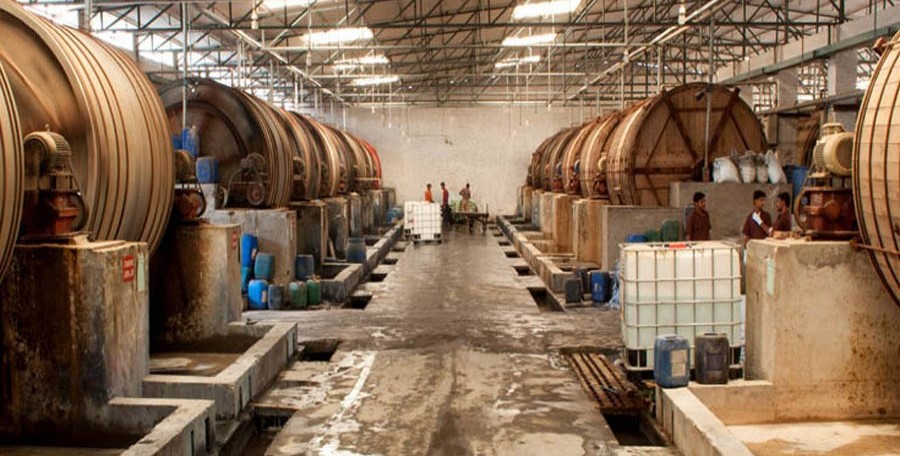India is one of the leading countries and centers of leather and tannery industries, which has faced some challenges in recent years.
By writing the current article, it has tried to address those challenges and their solutions.
The leather industry and its related industries are big ones based on the off-shoots of another one, the Meat industry, that is too decayable and make a very profitable business.
Those big profits make the leather industry more familiar, and it has grown up in many developing countries recently.
As a developing country, India's leather industry dates back to ancient times and creates many jobs and substantial financial turnover.
There are vast amounts of cattle even considered on a global scale.
Around 20 % of cows and 11 % of sheep worldwide are in India.

From the availability of the pastures and the grasslands, India is in excellent condition.
From the skilled force point of view, there are many experts in the central Indian cities dealing with the industry, like Chennai, Kanpur, Kolkata, Delhi, Jalandhar, Dindigul, and Trichi.
All these strong points make a tendency for the potential supplier, not only the Indian ones but foreigners.
All these strong points make a tendency for the potential supplier, not only the Indian ones but foreigners.
However, many shrinks are seen in the export.
COVID 19 Affects
It severely affected the leather industry because most foreign brands stopped their orders; because of the lockdown in early 2020, and shortly afterward, the lockdown reached India and made it captured (Started on March 2020).
So, most ordinary workers lost their job or had no pay (because they were daily-waged), and a significant percentage of the industry was halted.
Although, the employers tried to pay partial payments to the half and full-skilled workers not to lose them and keep them satisfied for the post-corona era.
The cargo going to export was piled in ports or warehouses, and the market activists fell into big trouble.
Shortly afterward, the lockdown regulations get eased. However, it was still a phased way, semi-staffed, and at a lower capacity.
The government tried to help the people who suffered a lot from the pandemic with money and food.
At the same time, some employers try to facilitate their workers with hygienic facilities to prevent covid-19.
For nutrition points, most of the workers are faced with a lack of items like meat, groceries, eggs, fruits, and vegetables and, in worse cases, malnutrition.
Although the conditions are coming back to normal, the covid makes some entities shut down permanently.
Although the covid-19 has harmed the Indian leather industry, have some opportunities for its future. While China, as the most significant player in the leather industry, is still involved in the various covid versions and lost their trade interactions, India, by the enactment of laws and regulations, is trying to absorb the brands being cut from China.

After China flight prohibition, for the items like leather shoes, the supply chain in India was broken, and the local states were forced to rebuild it based on the local capabilities.
Now, the Indian central government, with the aim of better arrangements and organizing in local supply chains, has decided the make Leather and shoe clusters, with an investment amount of US $ 795,000,000.00.These clusters create Job opportunities for 50000 people directly and 1.5 Million people indirectly.
Kanpur the Leather City of India
Kanpur city has been called Manchester of the east, now is famous for its leather industries and is considered the economic capital of Uttar Pradesh state of India, and has a significant role between the states and national exchanges.
There are many tanneries there in Kanpur that produce qualified leathers and have markets in India and abroad.
The leather industry started in the 19th Century and supplied the requirements of the great Britain army and had a significant role in two world wars.
From the 1940s (The independence era) to the 1970s, the industry experienced a recession, and afterward, gradually, it became the center of different leather products.
Now, 400 tanneries are working there, including 90 producing vegetable leather.
Apart from tanneries, the other leather products are active in Kanpur.
Factories, including medium-sized and small ones, deal with making footwear and sandals and selling their products in the local, domestic, and foreign market.
Other essential leather products of Kanpur are harnesses and saddleries, whose productions date back to the British colonization.
Jajmau area is the center that gathers the most tanneries together and works as a hub of the leather industry in Kanpur.
Another important industrial area is Panki, which is the place of both leather and pharmaceutical entities.
The other essential products of Kanpur are Cotton products, detergents, different kinds of furniture, Paint, and Cool storage clusters.
Real state is another business whose center is in Mukharjee Vihar, Chatai Mohal, and Jajmau.

Leather Faced Challenges
The leather industry and the tanneries are among the most polluting industries.
They use chemicals, including dangerous elements like Chrome salts, which are very dangerous for the environment, human beings, and animals.
The other pollutants are the residue of animal skins like waste from removing hairs and fleshing, which nearly all contain protein and other organic substances nearly in the tanneries' wastewater.
Another problem is bad-smelling.
Since most tanneries make their products on a traditional basis which belongs to a long time ago and has not changed over time, they seem to do it in a not proper and correct manner.
The way of storing the skins and wet blues, the animal wastes like urine and dung and remaining blood, and the using chemicals cause those smells.
Regarding water waste, it is better to use the proper cycle to remove the trash.
Regarding the smells, using fans diluting the weather can be helpful.
Removing impurities and using good scents, using the dust separators, and using active carbon are well.
Fast separating decaying the organic items and not storing them for a long time, discarding them is another solution.
Using vacuum filtration makes the mud dehydrated and reduces the bad smells.

0
0